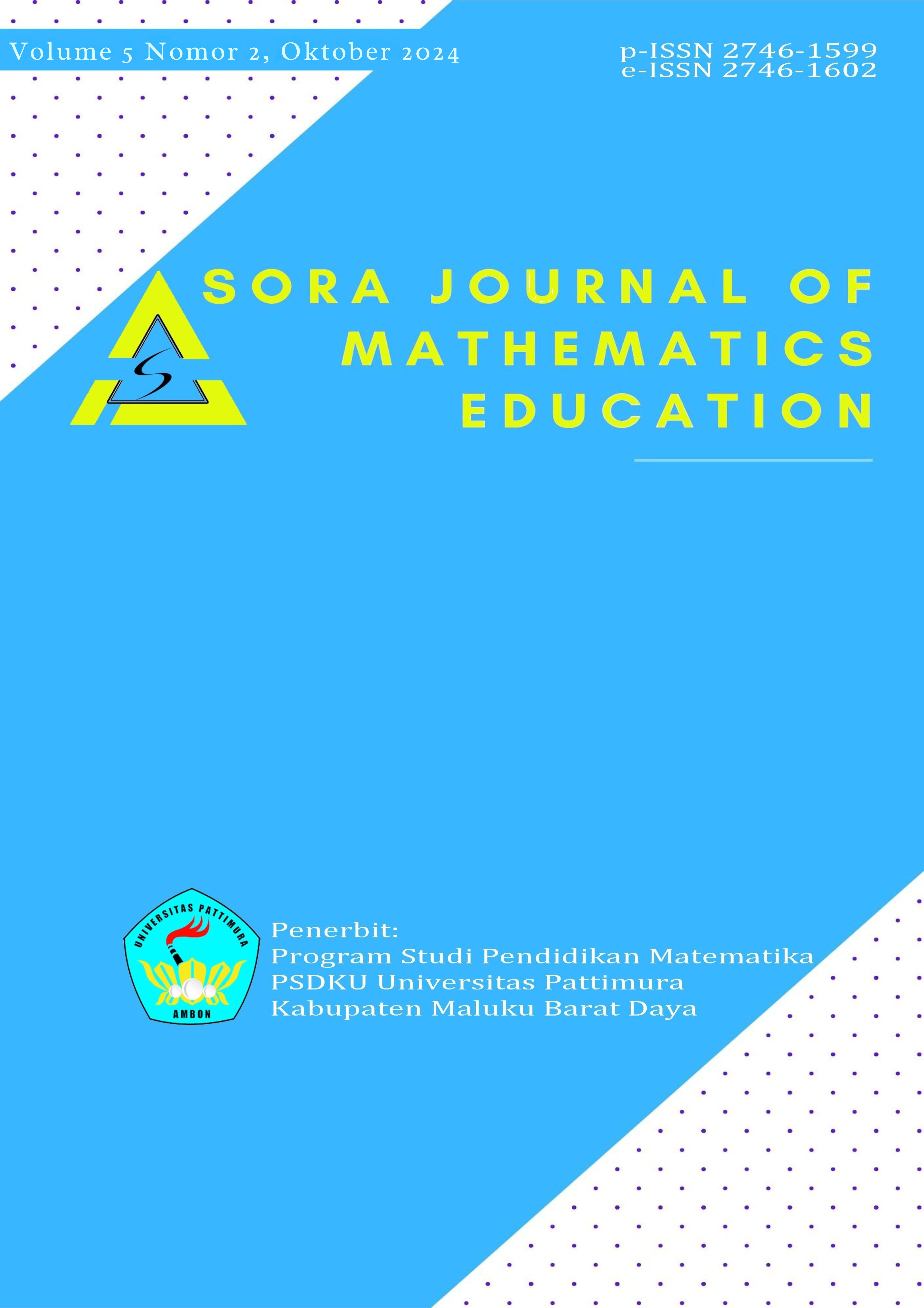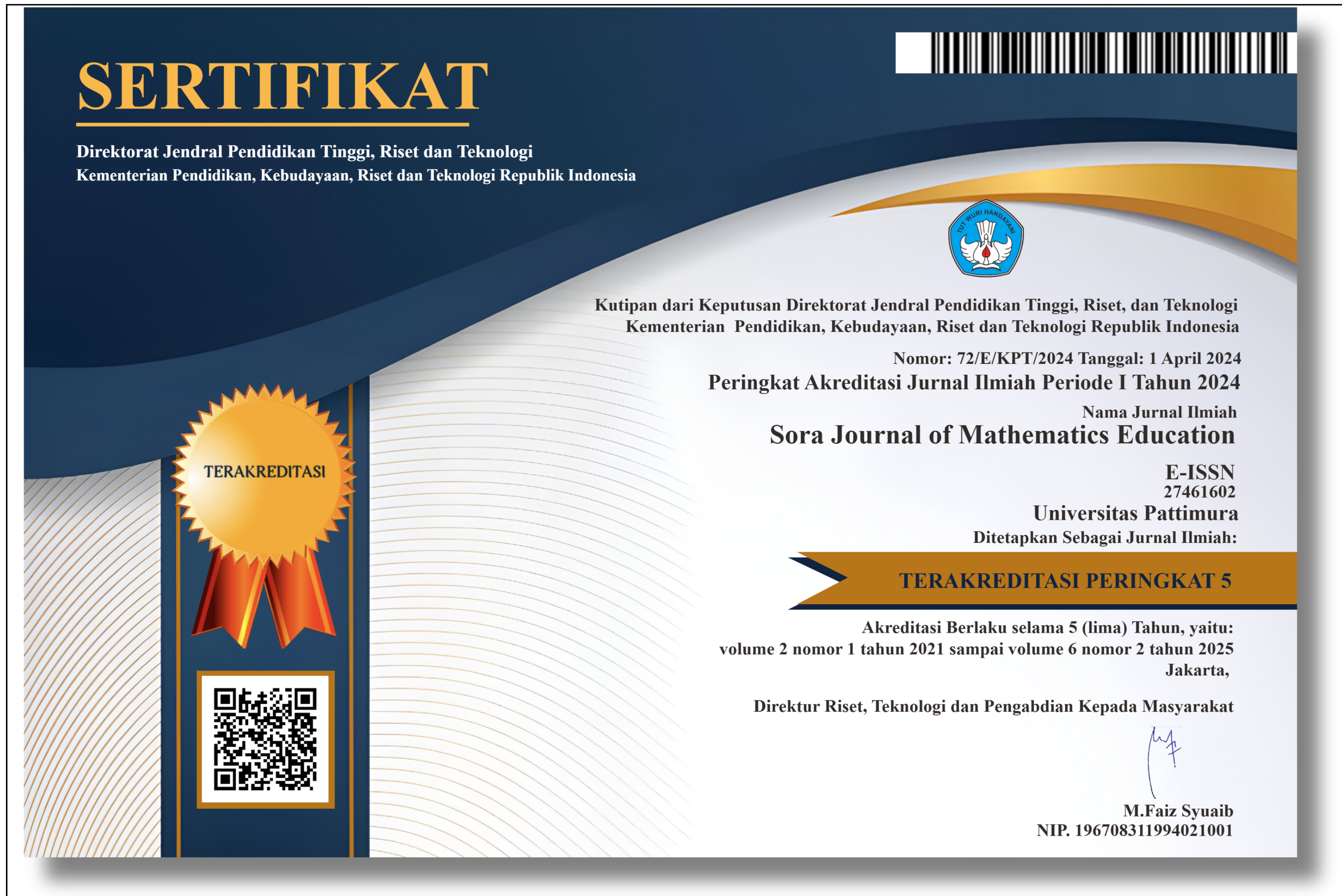THE ROLE OF MULTIMEDIA LEARNING IN REDUCING MATH ANXIETY TO IMPROVE STUDENTS' MATHEMATICAL ABILITIES
Abstract
Mathematics is an abstract theory, which causes many students to experience difficulties in learning it, leading to the emergence of math anxiety. This math anxiety affects students' attitudes and performance in mathematics. To reduce this issue, it is necessary to design learning that is enjoyable and motivating for students in mathematics education. Learning that utilizes digital technology provides a solution to reduce math anxiety. Students feel happy learning with interactive multimedia. Through multimedia, they can apply and solve problems using the theories they have learned. The use of technology in mathematics learning helps students achieve better results, enhances interaction and participation in learning, and offers significant opportunities to improve their learning experience.
Downloads
References
Alanazi, H. M. N. (2020). The Effects of Active Recreational Math Games on Math Anxiety and Performance in Primary School Children: An Experimental Study. Multidisciplinary Journal for Education, Social and Technological Sciences, 7(1), 89. https://doi.org/10.4995/muse.2020.12622.
Alzoubi, K. A. A. (2024). The Effect of Virtual Reality Technology in Teaching Mathematics on Students’ Ability to Process Data and Graphic Representation. International Journal of Interactive Mobile Technologies, 18(8), 27–39. https://doi.org/10.3991/ijim.v18i08.46901.
Caglar, M., & Senol, H. (2021). Factors that cause students to develop math anxiety and strategies to diminish. Cypriot Journal of Educational Sciences, 16(4), 1356–1367. https://doi.org/10.18844/cjes.v16i4.5984.
Chen, Y. C. (2019). Effect of Mobile Augmented Reality on Learning Performance, Motivation, and Math Anxiety in a Math Course. Journal of Educational Computing Research, 57(7), 1695–1722. https://doi.org/10.1177/0735633119854036.
Daud Yahya, M., Budi Susilo, C., Mayadiana Suwarma, D., Veza, O., Studi Sarjana Terapan Keperawatan Anestesiologi, P., Keperawatan, F., & Studi Pendidikan Guru Sekolah Dasar, P. (n.d.). Hubungan Penggunaan Multimedia dalam Pembelajaran terhadap Peningkatan Hasil Belajar Peserta Didik. Journal on Education, 06(01), 25–34.
Field-based Tasks with technology to reduce mathematics anxiety. (n.d.).
Gresham, G. (2009). An Examination of Mathematics Teacher Efficacy and Mathematics Anxiety in Elementary Pre-service Teachers. In Source: The Journal of Classroom Interaction (Vol. 44, Issue 2). https://www.jstor.org/stable/23869610.
Guzeller, C. O., & Akin, A. (2012). E-In-Text Citation: (Cem Oktay Guzeller, 2012) To Cite this Article: Cem Oktay Guzeller. International Journal of Academic Research in Progressive Education and Development, 1(2), 160–172. https://doi.org/10.6007/IJARPED/v1-i2/15766.
Hidayat, A., Asmalah, L., Pamulang Jl Surya Kencana No, U., & Selatan, T. (n.d.). Jurnal Emasains: Jurnal Edukasi Matematika dan Sains Augmented Reality pada Smartphone untuk Meningkatkan Motivasi Belajar dan Mengurangi Kecemasan Matematika Augmented Reality on Smartphone to Increase Learning Motivation and Reduce Mathematics Anxiety. https://doi.org/10.5281/zenodo.4301064.
Irene C. Mammarella (editor),Sara Caviola (editor), Ann Dowker (editor) - Mathematics Anxiety. (n.d.).
Kasus, S., Sekolah, S., Kejuruan, M., Rahyau, G., Ciamis, K., Pelajaran, T., & Santoso, E. (2017). Mengurangi Kecemasan Mateamtika dengan Bermain Game Logika. 1(2), 31–41.
Kour, S. J., Zia, M., & Rafaqi, H. (2024). FACTORS AFFECTING MATHEMATICAL ANXIETY: A SYSTEMATIC REVIEW OF RELATED LITERATURE. https://www.rajasthali.marudharacollege.ac.in
Olango, M. (n.d.). Mathematics anxiety factors as predictors of mathematics self-efficacy and achievement among freshmen science and engineering students.
Ross, E., & Marshman, M. (n.d.). Barriers to Integration: A Case Study of STEM-Learning in Mathematics and Digital Technology. MERGA.
Soewardini, H. M. D., Setiyawan, H., Suhartono, Amin, S. M., & Bon, A. T. Bin. (2019). An information technology-based learning to reduce math anxiety in solving problem. International Journal of Engineering and Advanced Technology, 9(1), 2117–2119. https://doi.org/10.35940/ijeat.A9670.109119.
Surjono, H. D. (n.d.). Peranan Teknologi Informasi dan Komunikasi (ICT) dalam Peningkatan Proses Pembelajaran yang Inovatif 1). http://blog.uny.ac.id/hermansurjono
Yaftian, N., & Barghamadi, S. (2022). The effect of teaching using multimedia on mathematical anxiety and motivation. JRAMathEdu (Journal of Research and Advances in Mathematics Education), 7(2), 55–63. https://doi.org/10.23917/jramathedu.v7i2.16141
Copyright (c) 2024 Sora Journal of Mathematics Education

This work is licensed under a Creative Commons Attribution 4.0 International License.








.jpg)



